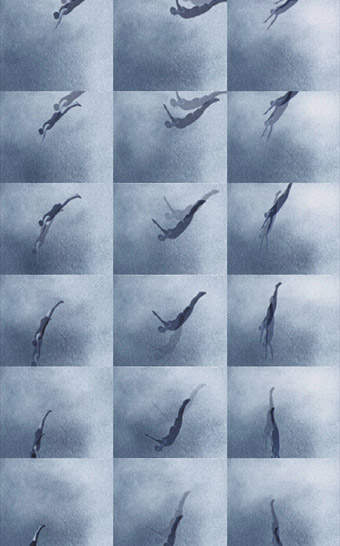 |
Brigita Ozolins, The Gorge |
On a hot summer’s day in 2006 a mother’s anxiety soars as she watches from the kitchen window of her home that hangs precariously from the steep cliffs of the Cataract Gorge in Launceston. Directly below, bodies plummet 20 metres from the bridge into murky waters. Among them she sees her son. In deliberately dropping himself into the water he becomes a member of the illustrious Tadpole Club, an institution almost 150 years old. The prefabricated steel bridge which is the site of this initiation was floated into place in 1863.
This rite of passage is replayed in Ozolins’ enigmatic work. And yet it is much more than descriptive. The work is a confluence of the artist’s practice, a residency program, the bicentenary of white settlement and one of Launceston’s most significant contemporary cultural sites, and the artist’s personal story. The exhibition is included in Launceston’s bicentenary program, It’s About Us, 2006, which presents a series of events around the theme of people who have made this city over the past 200 years. The images represented are a distillation from lived experience. The small weatherboard caretaker’s cottage in the installation was built in 1890 and is located at the entrance to the gorge, only a few minutes walk from the city centre. The caretaker was responsible for the pathway that the citizens of Launceston built as a pleasure walk. Now it is offered to artists for residencies. In 2005 Ozolins lived in the cottage for a few months. One of the first things she did was reorient the furniture in order to counter the vertigo which threatened to overwhelm her.
In The Gorge half a dozen figures glide through the air, mostly one at time. The soundtrack is beautifully mesmeric, luring the viewer into the imagery. However, a hint of menace awakens us to the sensation of the body suspended in space. This dissonance, gentle as it might first appear, increases as the infinite state of diving embeds itself in the viewer’s memory. One figure does not conform. Legs seem to reach out for something unattainable. The elegance of the dive is interrupted by a body out of control. This one is not diving but falling.
This seemingly simple aesthetic becomes a distillation of disparate moments bringing a recorded historical fact in a specific location together with a primal sensation and a private story. The public becomes personal. The personal becomes public. And yet it is not clear where one ends and the other begins. As the artist describes it, this is an exhibition about living on the edge.
Brigita Ozolins, The Gorge, Design Centre Tasmania, Launceston, July 1-30
Jane Deeth is a freelance writer, curator and educator based in Launceston, Tasmania and working on a PhD on viewer experience of contemporary art.
RealTime issue #75 Oct-Nov 2006 pg. 51
© Jane Deeth; for permission to reproduce apply to [email protected]








 back
back